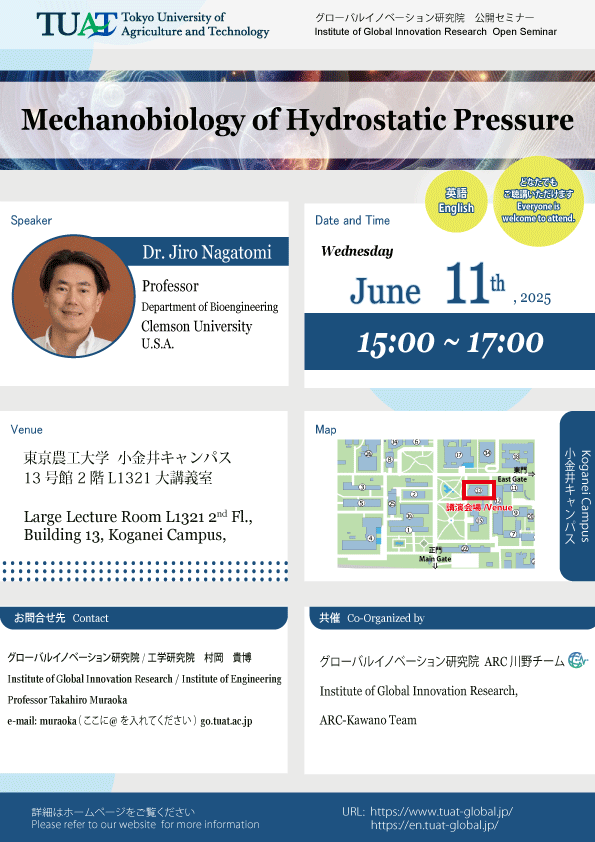Event
【GIR Open Seminar】 Dr. Jiro Nagatomi / Clemson University (U.S.A.)

| Date | 2025.6.11 (15:00 - 17:00) |
|---|---|
| Venue |
Large Lecture Room L1321, 2nd Fl., Building 13, Koganei Campus, TUAT |
| Speaker | Dr. Jiro Nagatomi |
| Affiliation | Clemson University (U.S.A.) |
| Title | "Mechanobiology of Hydrostatic Pressure" <Abstract> The cells of various organs are constantly subjected to changes in hydrostatic pressure through external factors like changes in altitudes or climate and internal factors like the containment of fluids within hollow organs or weight-bearing by the skeleton. Through numerous in vitro studies, the idea that cells are responsive to changes in hydrostatic pressure of physiological magnitudes has been proven for many other organ systems, including the vascular, neuronal, pulmonary, and urological organs. However, one of the most critical yet unanswered questions is how these cells sense the small changes in hydrostatic pressure. Some have examined the hypothesis that membrane-bound stretch-activated ion channels, such as TRP and piezo proteins, mediate hydrostatic pressure stimuli and calcium-dependent cellular responses. We have sought to investigate the role of select ion channels in bladder urothelial cell (UC) pressure mechanotransduction. Using a custom-made pressure chamber, rat bladder UCs cultured on tissue culture plastic dishes were exposed to sustained hydrostatic pressure (5-20 cmH2O) for up to 30 minutes. When compared to the control, UCs exposed to 10 cmH2O (5 minutes) and 15 cmH2O (5 and 15 minutes) exhibited a significant (p < 0.05) increase in ATP release. In the absence of extracellular calcium, ATP release due to hydrostatic pressure was attenuated. Blocking the L-type voltage-gated channel with nifedipine during pressure exposure did not affect ATP release. However, blocking TRP channels, stretch-activated channels (SACs) and the epithelial sodium channel (ENaC) with ruthenium red, gadolinium chloride, and amiloride abolished hydrostatic pressure-evoked ATP release. These results provided evidence that one or multiple mechanosensitive ion channels play a role in the mechanotransduction of hydrostatic pressure. However, it is unclear whether hydrostatic pressure could directly activate these stretch-activated channels or indirectly through stretching of the cell membrane due to cell deformation. Recent studies suggest that water transport across vascular endothelial cell (EC) membrane through aquaporin water channels under elevated hydrostatic pressure and subsequent changes in cell volume may mediate pressure sensing. We hypothesized that cell volume changes can activate membrane-bound ion channels such as TRPV4 to allow calcium entry into the cells, leading to subsequent signaling events. To test this hypothesis, we exposed human aortic ECs to physiological levels of hydrostatic pressure (50 or 100 mmHg) using a custom device and monitored the intracellular calcium transient. Live cell imaging was performed to collect fluorescence images (intracellular calcium and cell membrane) while cells were exposed to a sudden increase in hydrostatic pressure or hypotonic stress. The results showed that both HP and hypotonic stress elicited oscillatory calcium increases (3~4 peaks over 10 min) in ECs. Moreover, small increases in cell height were observed immediately after pressure application. The pressure-induced calcium oscillation was also observed in the presence of a TRPV4 inhibitor, indicating that cell swelling may be part of the pressure-sensing mechanism, but calcium entry through this particular ion channel may not be involved. Further studies are needed to more precisely measure these small changes in cell volume and subsequent ion channel activation under pressure to improve our understanding of hydrostatic pressure mechanotransduction. |
| Language | English |
| Intended for | Everyone is welcome to join. |
| Organized by | Institute of Global Innovation Research, ARC-Kawano Team |
| Contact | Institute of Global Innovation Research, Institute of Engineering Prof. Takahiro Muraoka e-mail: muraoka (at) go.tuat.ac.jp |
| Remarks | This seminar will only be held face-to-face. |
このページの上部へ